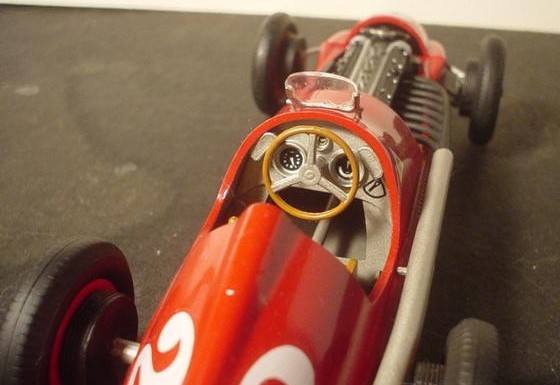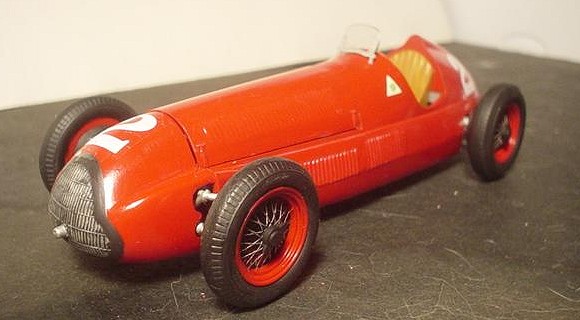
SMER 1/24 Alfa Romeo 156
| KIT #: | ? |
| PRICE: | $25 from ebay |
| DECALS: | One option |
| REVIEWER: | Mark Hiott |
| NOTES: | Rare kit with nicely molded detail |

| HISTORY |
 Emilio Giuseppe
Farina, born October 30, 1906 in Turin, Italy, stands out in the history of
Grand Prix motor racing for his much copied and admired 'straight-arm'
driving style; and his status as the first ever Formula One World Champion.
Emilio Giuseppe
Farina, born October 30, 1906 in Turin, Italy, stands out in the history of
Grand Prix motor racing for his much copied and admired 'straight-arm'
driving style; and his status as the first ever Formula One World Champion.
Nicknamed "Nino," he was a qualified medical doctor who began his motor
racing career in hillclimbs, graduating to circuit racing with Maserati.
But it was not until he moved to Alfa Romeo, as number two driver to the
great Tazio Nuvolari, that his racing career really blossomed.
Entering post-war Grands Prix in a privately-owned Maserati, Farina took a win at the 1948 Monaco Grand Prix. For the announced inaugural World Championship for 1950, Farina secured a drive alongside Juan Manuel Fangio and countryman Luigi Fagioli at the dominant Alfa Romeo team, driving the invincible 158 Alfetta cars. Farina took 3 wins from the 7 races of the 1950 season, securing himself the first ever World Championship. It was the pinnacle of his career
| THE KIT |
I bought this kit off Ebay awhile back and having built SMER aircraft kits, was not expecting too much. I was quite surprised when the model arrived and I was able to look at it.
 Inside the RoG type
box, I found the kit nicely molded in white plastic. Parts number about 40
or so. The body follows standard race car practice in that the body is in
upper and lower halves. The engine is quite nice with separate head and
water pipes. The interior is sparse (as was the real thing) and the axles
are supplied with springs and decent looking brake drums. The parts suffer
from some flash, but not near as much as I had expected.
Inside the RoG type
box, I found the kit nicely molded in white plastic. Parts number about 40
or so. The body follows standard race car practice in that the body is in
upper and lower halves. The engine is quite nice with separate head and
water pipes. The interior is sparse (as was the real thing) and the axles
are supplied with springs and decent looking brake drums. The parts suffer
from some flash, but not near as much as I had expected.
Also in the box is a clear piece for the windscreen and some strange clear discs to make "wire" wheels.
The instructions are a single page with decent assembly steps. The back side of the instructions have a copy of the box art that I suppose one could frame. The instructions were all printed in Czech, so they were of no help to me. No paint colors are given. The decals in the box were no good, having suffered form old age.
| CONSTRUCTION |
 No real problems were in countered
during the build, as the kit is quite simple. There were a few fit
problems, but nothing too serious. Assembly follows the standard steps;
engine, chassis, interior and wheels. There was a seam where the upper and
lower body parts came together, a little filler and light sanding was all
that was required. I was unable to find any good references on the engine,
so I left off any ignition wiring. Hopefully I can add it at a later date.
No real problems were in countered
during the build, as the kit is quite simple. There were a few fit
problems, but nothing too serious. Assembly follows the standard steps;
engine, chassis, interior and wheels. There was a seam where the upper and
lower body parts came together, a little filler and light sanding was all
that was required. I was unable to find any good references on the engine,
so I left off any ignition wiring. Hopefully I can add it at a later date.
The only addition I made to the model was a set of Herb Deeks Models wire wheels. I highly recommend these sets to anyone who is building a kit that requires wire wheels. Easy to use and reasonably priced ($10 + shipping) the sets include an outer rim, an inner rim and 4 turned aluminum center spindles. The instructions give several different ways to use the wheels and are very easy to follow.
The kits wheels are of the 2-piece type and have the center molded with the outer part. Carefully remove the center and glue the wheels together. It's a simple matter of forming the Deeks rims to fit the now empty wheel centers. The kit part removed is then glue on the back behind the Deek rim.
| COLORS & MARKINGS |
 I painted the inside of all the body
panels aluminum. The frame is molded into the lower half of the body and I
painted this black. The engine was painted aluminum with a black exhaust
pipe. The car had a brown leather seat, so I painted this part flat brown.
I painted the inside of all the body
panels aluminum. The frame is molded into the lower half of the body and I
painted this black. The engine was painted aluminum with a black exhaust
pipe. The car had a brown leather seat, so I painted this part flat brown.
The body was hand painted with a brush using MM Acryl Bright Red. I have not had much luck airbrushing acryl paints, but they take to the brush wonderfully. They go on thin and dry to a smooth glossy finish. There are sometimes a few air bubbles, but I have never had a problem with them.
As the kit decals were no good, I used a set of Fred Cady decals. Gauges were added to the instrument panel, as well as an on/off switch. I don't really like Cady decals, as they tend to "stick" wherever you place them and are hard to move around. The nose decal gave me problems.
| CONCLUSIONS |
A very nice build from a kit that surprised me. I understand these kits are rather rare, but if you can find one, I suggest you get it. It makes a great addition to my growing collection of early Indy/F1 cars.
August 2005
Copyright ModelingMadness.com
If you would like your product reviewed fairly and fairly quickly, please contact the editor or see other details in the Note to Contributors.
Back to the Review Index Page 2018